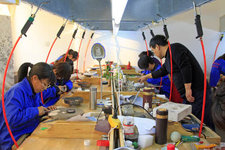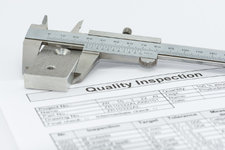5 Misconceptions About QC in China
How effective is QC in China?
All buyers have their own set of quality standards and the price they’re willing to pay for products. The seasoned buyer of products manufactured in China can offer a host of stories about success, failure, and the surprises they’ve encountered along the way. When it comes to manufacturing, perhaps no other area is more surprising than controlling product quality.
That’s why in this bulletin we’re revealing five of the industry’s top misconceptions about QC in China. By learning about these errors in thought, you’ll be better prepared to manufacture in China, achieve consistent product quality, and encounter fewer surprises.
5. Chinese factories only make poor quality products
This first misconception is one of the most common surrounding quality control in China. What thoughts enter the mind of the average Western consumer that hears or reads the phrase, “Made in China”? Notions of cheap quality, low cost, and for some, child labor, are likely among them. And this should come as no surprise.
For more than the past two decades, China has garnered the reputation of a manufacturing haven for cheap, low-quality products. Lead paint used in manufacturing in China prompted a major toy company to make a major recall effort in 2007. Employment of child labor in Chinese factories has also made headlines. Even as recently as earlier this year, at least one company, North America’s largest wood flooring distributor, was found to be allegedly manufacturing a toxic product that was cheaper to produce than the safer alternative. But there’s something quite telling in this last example.
Demand for lower cost can yield lower qualityAdmittedly, it is true that many Chinese factories can, and are more than happy to, manufacture poor quality products — even those that don’t meet Western regulatory standards for safety. How does this happen? More often than not, substandard products are manufactured because the buyer prioritizes lower cost over higher quality. That’s right. It’s often the buyer that opts for lower quality in order to keep prices low and be competitive, in spite of the predictable need for the factory to cut corners to remain profitable in response.
Lack of detailed specifications
Other times, a buyer will place an order with a supplier for a product and not specify the grade of material or exact component that must be used. In turn, the factory may choose to use cheaper materials and components to cut costs and increase margins. Precious metals that should be used for jewelry items might be substituted with cheaper alloys. A higher-end circuit board needed for a tablet PC might be switched out with a lesser, locally-sourced alternative. Factory management may make these substitutions, with or without consent from the buyer, unless the buyer specifies otherwise.
4. Factory staff clearly understand the buyer’s requirements
A common error on the part of the buyer is to assume that the factory manufacturing their product has internal QC and production staff that are both capable of assessing the product quality and clearly understand the buyer’s expectations. This misconception is due to a couple of major factors.
Communication through sales representatives
One reason production staff and internal QC often misunderstand or misinterpret client requirements is due to the fact that the buyer is usually communicating through a sales representative of the supplier. Rather than talking directly with staff that are actually handling the product on the factory floor, the buyer is usually forced to communicate their expectations first to a sales rep, who then must translate this information and convey it to production and quality control staff. Not only does the salesperson generally lack the same level of technical expertise that QC and production staff hold, but aspects of the buyer’s message could be lost in translation. These problems may be compounded if the buyer is working through a vendor or trading company, which adds another degree of separation.
Whether a factory has a lot of experience manufacturing a particular product or very little, QC in China can be difficult if the buyer assumes too much. There are many products considered household items in many Western countries, but very foreign to Chinese. A classic example of this is cookware. A milk frother, a garlic masher, and a coffee machine are all products with which the average Chinese person is unfamiliar. We’ve even seen one case where a butter dish was manufactured too small and couldn’t actually hold a whole stick of butter because the Chinese supplier producing it wasn’t familiar with the standard size of a stick of butter.
So how can a buyer avoid misunderstandings and be confident that their Chinese supplier understands their expectations? Buyers need to provide detailed specifications and requirements to the supplier before placing the order. This could mean providing CAD drawings to show product dimensions, artwork and Pantone codes to show packaging and color requirements, or — perhaps most helpful — an approved “golden sample” and a list of acceptable and unacceptable quality defects (see Never Manufacture Without a Golden Sample). Of course, you may want to hire the help of a third-party inspection company to visit the factory and verify the quality of the goods independently as well. But the key takeaway here is to provide your supplier with as much information as you can. Then elicit feedback about what is possible and what is not possible regarding meeting your product standards at the agreed upon price. Clarifying requirements early can save you from having to deal with costly surprises when it may be too late.
3. QC companies can impose their will on suppliers
Many experienced buyers insist on hiring their own QC staff to carry out pre-shipment product inspection. As was pointed out above, having your own product inspectors visit the factory is a prudent move, as you can be more assured that quality control is being completed properly and meets your own expectations.Many buyers, however, set unrealistic expectations when it comes to the authority of independent QC staff. Some buyers ask their QC company to schedule an inspection of an upcoming order and then think their involvement is finished. What buyers sometimes don’t realize is that their QC company can’t force their supplier to do anything against their will. Rather, the QC company must get expressed permission from the supplier, often in writing, before they can enter a factory and carry out an audit or product inspection. This can be difficult, particularly concerning QC in China.
Understandably, suppliers typically prefer to avoid the added oversight that third-party inspection or auditing can bring. And suppliers can get creative about delaying or avoiding this oversight. A supplier may delay inspection by telling QC staff that they need to confirm some information with the buyer before booking. They might also be altogether unresponsive or unreachable when attempts are made to contact them about scheduling. In any case, when a supplier is uncooperative with booking, it’s the QC company’s responsibility to inform the buyer and the buyer’s responsibility to press the supplier accordingly.
Third-party QC providers also rely on the supplier to allow inspectors to carry out certain tests or inspection procedures. One such example is the carton drop test, which is a standard test but can be destructive to the product (see 5 Steps to the Carton Drop Test). A supplier may also need to make certain testing equipment available for inspectors to use, if the buyer wants particular testing to be performed.
Finally, QC staff do not have the authority to dictate to the factory whether or not an order should ship. It’s up to the buyer to review the inspection results and determine if an order should be held for rework. If so, the buyer needs to notify the supplier accordingly.
2. An inspection result dictates if an order should ship
If you’ve considered hiring a third-party inspection company to visit one of your suppliers, read on — almost every buyer experiences this the first time they receive an inspection report. Some buyers receive an inspection report with a result of “FAIL” and, without even considering why their order failed inspection, contact the supplier and demand they hold the shipment and rework. There are a couple reasons why this kind of “knee jerk” reaction is especially common early on.First, the buyer may not realize that it is exclusively their decision whether or not to ship the goods. Just because an inspection report shows a result of “FAIL” doesn’t mean the buyer cannot accept the issues found during inspection. Similarly, an inspection report might be issued with a result of “PASS”, but the buyer might feel there is an issue that needs to be addressed before the order can ship.
Secondly, the buyer may not yet have established a firm tolerance for defects and other issues related to the product. If a buyer is unfamiliar with the inspection sampling process and acceptable quality limits (AQL), the inspection company will often default to using their own recommended tolerances for defects. What can then happen is the buyer is surprised either by a failing inspection when they’re able to accept the defects found, or a passing inspection when they’re not (for more about AQL, see Inspection Level And Selecting An AQL). The bottom line here is that it’s essential to spend the time to understand the inspection report, ask for feedback from the supplier and QC inspector when needed, and offer your own. Remember, the buyer makes the final call on accepting or holding an order.
1. QC companies work with the factory to eliminate causes for problems
This last misconception about QC in China concerns the limitations of product inspection. Put simply, product inspection is not a “silver bullet” or a “cure-all” solution to quality problems. Most QC companies can visit a factory on your behalf, verify whether or not the product meets your specs and standards, and report back any issues found during their inspection. And although a product inspector can sometimes suggest possible causes for defects and other issues found, they’re rarely able to pinpoint the processes at fault and advise corrective action. This capability is normally held by a manufacturing consulting firm capable of process auditing (see Process Auditing vs. QC Inspection).Third-party QC inspection is valuable in providing a buyer with an unbiased report of the status, quality, and condition of an order at a relatively low cost. A product inspection offers real transparency and insight into mass production, allowing the buyer to make informed decisions about shipping, rework, and design modification prior to receiving the finished goods. It’s generally the buyer’s responsibility to work with the supplier on developing corrective or preventative action to decrease or eliminate issues with production found during inspection.
Key Takeaways
QC in China can be a tricky business. Buyers and suppliers each have their own set of expectations. One could argue the purpose of quality control is to identify any discrepancies between those expectations. By understanding the following points raised by common misconceptions, buyers can take a major step toward better and more consistent product quality:
- Many Chinese factories CAN and DO make a quality product
- Buyers must be extra careful to clarify product requirements when placing an order with a supplier
- Independent QC firms do NOT have authority over suppliers
- It is the buyer that decides if an order will ship, NOT their inspection company; and
- Inspection companies find and report problems; buyers and suppliers find the solutions
Now you’ve learned about some common pitfalls in thinking about QC in China. Can you think of any others? Tell us about them in the comments below!
About John Niggl & InTouch Manufacturing Services
John Niggl is a Client Manager of InTouch Manufacturing Services, which provides solutions to quality and overseas manufacturing issues through product inspection and related quality control services. John is also Editor of the QC-related blog, Quality Wars.

















Comments
Great article!
Thanks for these well thought out things to consider about QC in China. We have been manufacturing in Suzhou for 20 years, as silk is from China and our products are made of silk it makes sense.
We do send “golden samples”, Pantone colors, patterns, etc. And request pre-production samples sent to us before approving each order. We keep careful specs on hand here, colors and measurements.
We have pretty good, consistent results with this method.
If we do get a bad batch of an item we sell it here in USA for half price and the supplier in China accepts partial payment, so not much is lost or wasted.